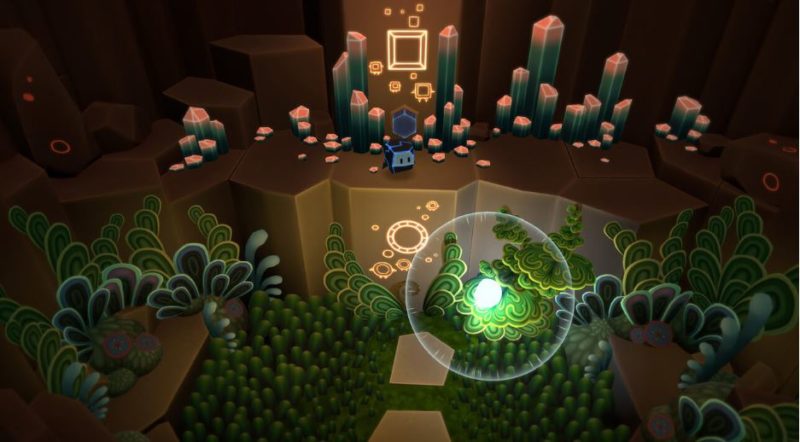Pode is a relaxing puzzle game for the Nintendo Switch made by Henchman & Goon, a Norwegian indie studio. The game follows the story of two adorable protagonists: a fallen star named Glo, and Bulder, the small rock trying to help Glo get home. Glo and Bulder must use their contrasting abilities in order to explore and scale the caves of Mount Fjellheim and reach the top.

Pode is absolutely gorgeous, although not without its problems. The game’s vibrant caves come alive as you interact with them, and the soft light Glo gives off as it waddles around the cave only adds to the muted beauty of the scenery. The flora and water are especially noteworthy, as are the patterns and structures left copiously throughout the game. In both docked and handheld mode, the game ran perfectly with short load times and no noticeable slowdown.
The game’s sound is charming and unobtrusive, perfect for a puzzle game like this, if a little underwhelming at times. The soundtrack is mostly contemplative and plucky strings and feels right at home in the understated mystical setting. Glo and Bulder communicate in chirps and produce low hums as they use their powers, and some objects land with soft thuds.
The story is told entirely through the incredibly emotive protagonists, glowing sigils on the walls, and the world around them, but the simplicity of the controls ensures that you’ll never get lost. The setting itself, however, can sometimes be overwhelming. With the sheer amount of stuff onscreen once you’ve explored a level for a bit, it can be hard to solve some puzzles less because of their challenge and more because it’s hard to make out the characters and the interactive pieces of the environment.

One or two players control Glo and Bulder, either switching between the two or each controlling one character. It was clear that Pode was meant to be played cooperatively, as piloting both of the slow-moving characters proved to be a bit cumbersome, but playing single player was still doable and entertaining.
Glo and Bulder each only have a small number of ways they can interact with the environment, but each of their few mechanics are used to great effect. Both spirits can project an aura in their immediate radius, affecting the world around them both in look and function. Glo can use its aura to make plants grow, reduce obscuring mold, and illuminate clues and secrets on the cave walls. Bulder, on the other hand, can use its aura to interact with the rocks of the cave itself, making rocky platforms sprout from the ground and using secret passages. It can also pick up blocks and its starry friend in its body, launching or repositioning them as necessary. Glo is light and can fall slowly and stand on water, while Bulder sinks and can activate pressure switches. The puzzle designs make great use of these properties, encouraging you to think two steps ahead about where the two will need to be in order to navigate increasingly complex levels.
New mechanics and abilities are introduced every few levels, such as root systems that extend the reach of Glo’s aura and an ability that allows Glo to set down its aura and return later, even taking Bulder with it. Each new idea is given the time it needs to breathe and be understood and offers interesting new dimensions to the puzzle solving process.

Unfortunately, the pacing comes to a halt at the end of each set of levels. The final level of each area is wildly different from the rest of the more platforming and exploration-focused gameplay. Instead, these rooms are more gimmicky and offer nothing but a cryptic sigil as a motion towards often somewhat counterintuitive solutions. With no way to progress without completing these puzzles, I found myself frequently and frustratingly stuck, unsure what to do without a lot of trial and error.
The collectibles were also a little lackluster, with most being as simple as taking one of the characters slightly off the main puzzle path to use their aura on a suspicious wall or rocky flower. A generous level selection system allows easy access to previous levels to pick up any you’ve missed the first time around.

Overall, Pode was a charming and beautiful puzzle experience with some interesting mechanics and gorgeous art that was only slightly hampered by some cryptic puzzles and busy scenery. I’d recommend it to anyone who is intrigued by the art style or is into physics/platforming puzzles as a genre, with a strong suggestion to find a player two to share this journey with.
Score: 7.5/10
Here is the Pode Nintendo Switch Trailer:
Nintendo Switch Review
-
Overall Score - 7.5/107.5/10
The queer SJW gamer your parents warned you about, probably. I'll play anything once, but have a specific penchant for roguelikes, artsy puzzlers, and rhythm games.





More Stories
Nintendo Download Update (December 18, 2025)
DAIMON BLADES Preview for Steam Early Access
ReStory Preview for Steam